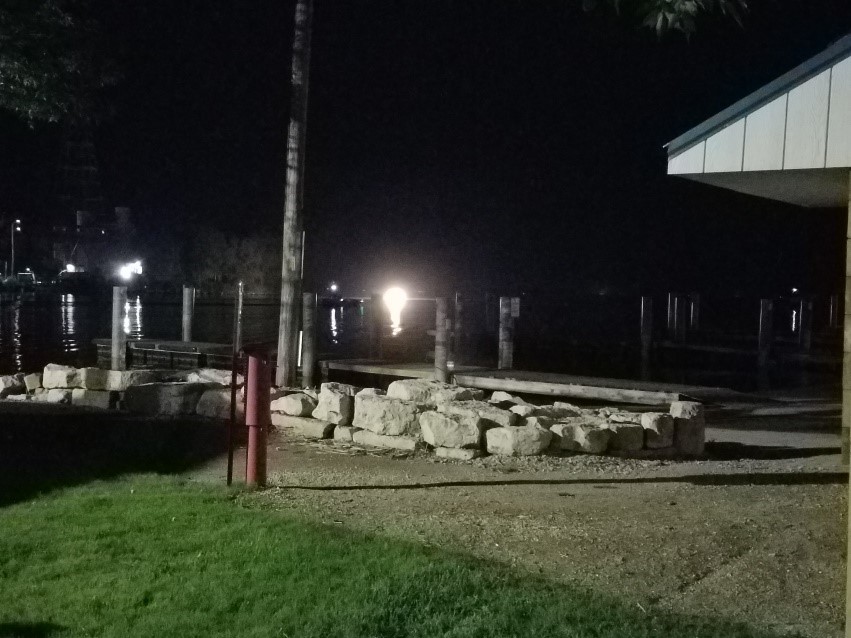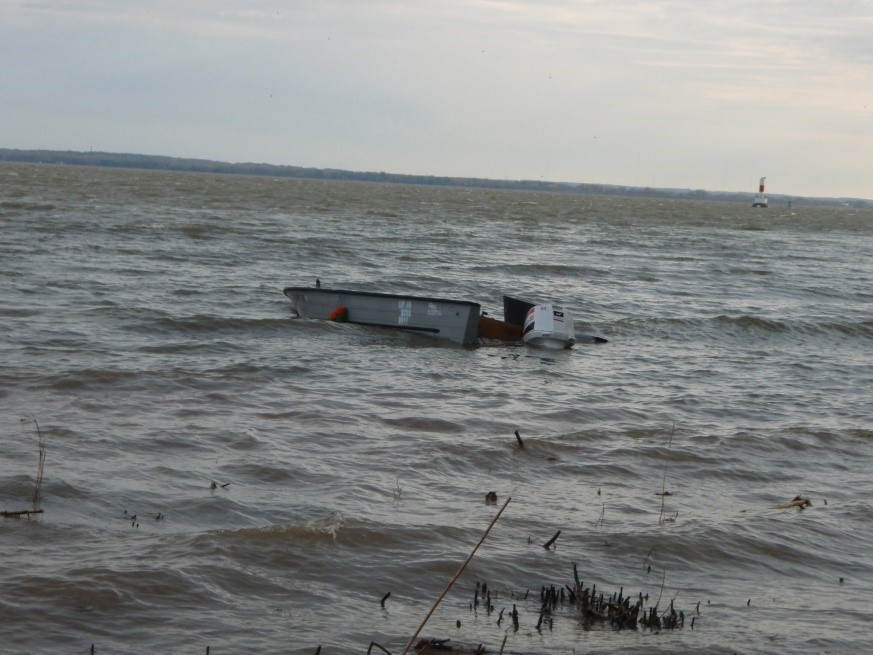Treat life jacket like your license, boat lights a must, be weather-wise & hunt your plan.
An article from WWA’s Words From The Wardens.
This article originally appeared in Wisconsin Waterfowl Association’s June, 2019 eNewsletter.
 By WDNR Recreation Warden Darren Kuhn
By WDNR Recreation Warden Darren Kuhn
Hello! I am the recreation warden stationed in Green Bay. In fact, I have worked most of my 21-plus year career at the Green Bay Station.
Over the years I have talked to duck hunters with the big trailers setting up at 3 a.m. in rural fields, the shore hunters who lug their decoys and gear through the cattail lined shorelines, open water hunters with the layout boats ratchet strapped to their chase boats, and the hunters jump shooting out of their leaky canoes.
I think I have seen it all: the good, the bad, the legal, the illegal, the ethical and not so much.
I also thoroughly love to duck hunt. My job doesn’t allow as much time in the marsh as I would like. But, working out of Green Bay offers me some excellent duck hunting opportunities. I also like to use my vacation time to hunt South Dakota and Manitoba.
With all, in this column I will talk about some of the boating situations that I have seen; the boating safety risks that some hunters take and how these risks can be mitigated.
Boating risks (unbelievably) still happening!
The No. 1 risk – and I can’t believe that this still happens – are hunters going out without any personal flotation devices (life jackets). State statute requires one wearable type life jacket for each person on board the boat and a throwable type, like a seat cushion, for all boats greater than 16 feet in length.
Every season I encounter hunters without any life jackets in their boats. The excuse is almost always the same: “I was excited to get out hunting and forgot them at home.” Please start treating your life jackets like your license, blind bag or your shotgun. Don’t go out hunting without it.
To stay on the topic of life jackets, state statute requires the life jackets be on board and be readily accessible. We strongly encourage wearing it. However, you don’t legally have to wear it; but, it has to be available in the instant that you might need it. Let’s delve into that a little bit.
Can you find your life jacket as your boat is capsizing? Doubtful
A hunter goes out in his/her duck boat that might be a bit tippy due to the smaller size, construction or age. This boat is now loaded to the hilt with decoys and the hunter’s trusty Labrador. That dog wants nothing more than to get into the ice-cold water to retrieve a limit of ducks; and, therefore, is bouncing all around the boat with excitement. It is pre-dawn hours because the hunter wants to get to their spot first. Since duck hunting is inherently a wet sport, the hunter is wearing waders. In this scenario, where are the life jackets? What I have seen in my career is that about 8 out of 10 times the life jackets are stuffed in a compartment under the decoys and the excited dog — or stuffed so far up under the bow everything must be moved to get to them. Is this readily accessible? How much time is it going to take to get the life jackets if needed in an emergency? How long will it take for hypothermia to set in if a hunter goes into the water? How fast will the hunter stay afloat once the waders fill with water? Why not wear your life jacket?
Life jackets come in all shapes, sizes and colors – including camouflage. There are inflatable types that you wouldn’t even know you are wearing, or float coats that double as your hunting jacket. I have personally talked to hunters who have been in this same situation. Lucky for them they lived. They almost always say something to the effect of, I will never go out without a life jacket again. I also have talked to hunters whose boats capsized and they were wearing their life jackets and their answers are almost all the same – I would have died if I wasn’t wearing my life jacket.
The law in Wisconsin does not mandate that duck hunters wear their life jackets. It simply requires that there is at least one wearable life jacket for each person on board and that they are readily accessible. Since that is the case, from one hunter to another, would you please consider wearing your life jacket when you head out on the water? There are way too many near death experiences where a hunter simply got lucky and, tragically, some where the hunter did not. In these situations, wearing a life jacket might have been the answer.
Boat lights: LED light bars do not replace required lights
Now I want to switch gears and talk about boat lights.
Over the last few years I have seen a lot more duck boats hitting the water with these big LED light bars to help hunters find their way in the dark. These light bars can’t be used in place of your required boat lights.
State statute requires that when a motorboat is operated between sunset and sunrise the boat must display red/green navigation lights on the bow and a white light visible 360 degrees around the boat. These lights are not designed to assist the hunter in seeing in the dark, but rather to let others on the water know which direction your boat is travelling so that the rules of the road, or in this case the water, are followed to avoid a collision. We all know once the word gets out that the ducks are down the marshes, shore lines and favorite sloughs are going to fill with hunters all with the same goal of getting to their spot first. More hunters mean an increased risk of a boat crash. Using your boat lights as designed can reduce this risk.
LED light bar akin to driving car with brights on, blinding others
State statute also prohibits having additional lights that drown out the required navigation lights. This is exactly what these LED light bars do. Therefore, when a boat is operating with these bow mounted LED lights and all anyone else sees on the water is blinding white light, there is a safety concern and law violation.
A duck boat returning to the landing after hunting hours should not look like this one, above, but none the less this is exactly what this is. I took this picture at the Green Bay Metro Boat Landing. Blinding on coming boaters creates an unnecessary hazard on the water. This is not any different than driving with your high beams on when there is oncoming traffic on the highway. There is nothing wrong with using these extra lights to tuck into your favorite spot, but they are not to be used for navigation.
Wisconsin weather changes – sometimes without warning
Hunters also need to pay attention to the weather and wind forecasts and what their boat’s capabilities are. I have been told that the best duck hunting is when it is rainy and foggy. The ducks fly lower, or so I’ve been told. Hunters need to pay attention to the wind to figure out their decoy placement. Wind and weather also plays a part in boating safety. Working on the waters of the Bay of Green Bay it is always choppy in the fall when the divers show up. A phrase that I commonly use in my enforcement contacts is “just because you can, doesn’t mean you should.”
In the fall, weather conditions on the water can change rapidly and hunters need to be aware of these changing conditions. Hunters need to think more of staying safe and returning home to hunt another day, after all duck hunting is a sport and is meant to be fun. In the picture above, this hunter had no thought when he left the landing with his son and friend that his boat would sink just before they made it to their spot, but it did. I was able to get the hunter, his son and friend to safety and this should be a reminder that no duck is worth it, and Mother Nature will always win.
Plan your hunt, hunt your plan
Hunting from a boat, whether along a shore line, tucked in the vegetation or on the open water poses yet another challenge – safe zones of fire. Hunters need to have these conversations to ensure that everyone in the boat is on the same page. “Plan your hunt, hunt your plan” is a phrase that is often taught at hunter education classes when talking about deer drives, but also holds true while hunting from a boat. Some questions that need to be answered before the first shot is fired, and preferably before the boat is even put in the water include: Are we going to take turns shooting? If not, then who is going to shoot in what direction? Are we going to shoot while seated or are we going to stand and shoot? Once the plan is in place there can’t be a deviation from the plan. A deviation from the plan could have disastrous results. I have seen first-hand the results if the plan is not put into place and I would not wish that on anyone.
Hopefully this column puts some perspective on our sport. More importantly, hopefully the issues I discussed will keep you all safe. We hunt for fun and often times lose sight of some of the hazards that are preventable. Life jackets, boat lights, changing weather conditions and planning the hunt and keeping to the plan are all things that can lead to a fun, successful and safe hunt and if you are planning a hunting trip to Green Bay, look me up and I will give you a scouting report.
Safe hunting and good luck.
If you have information regarding natural resource violations, you may confidentially report by calling or texting: VIOLATION HOTLINE: 1-800-TIP-WDNR or 1-800-847-9367. The hotline is in operation 24 hours a day, 7 days a week. Trained staff relay report information to conservation wardens


